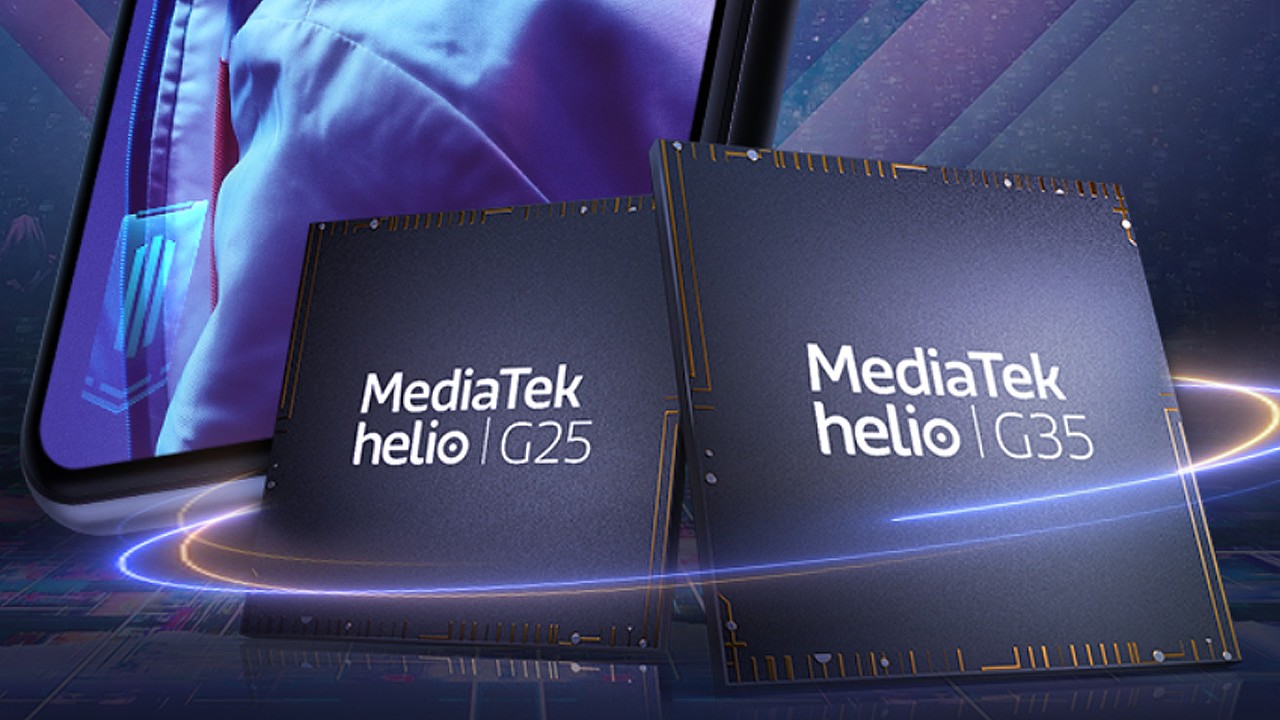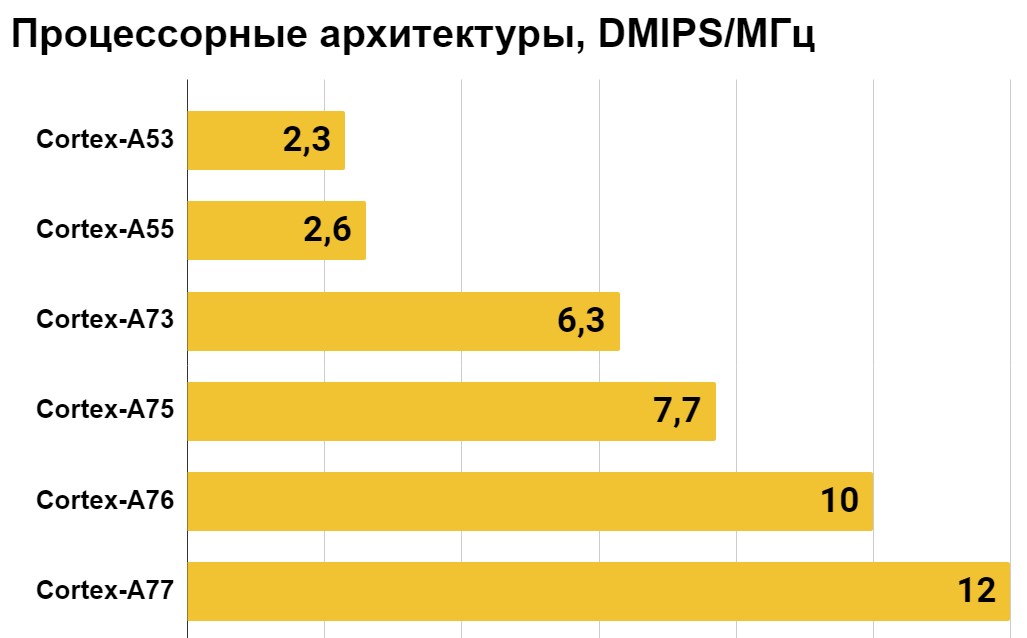MediaTek Helio and Dimensity: which processor to choose a smartphone with?
We independently test the products and technologies that we recommend.

MediaTek Processor Series
Helio A20 and A22 are the only remaining quad—core MediaTek processors. They are built on a low-performance, but very energy-efficient ARM Cortex-A53 architecture (2.3 DMIPS/MHz) and a 12-nanometer process technology (all Helio series processors are based on the same process technology). A20 and A22 differ insignificantly from each other — the second has a 200 MHz higher frequency. The graphics accelerator is the same PowerVR GE8300, and the RAM is strictly single-channel.
Helio A25, P22, P35, G25 and G35 are MediaTek's junior octa—cores on the same Cortex-A53 architecture, the core frequency varies from 1.8 to 2.3 GHz. We got a slightly faster PowerVR GE8320 graphics card and already dual-channel RAM (except A25, which is still single-channel). The G25 and G35 chips, like other representatives of the G-series, are made with an emphasis on mobile gamers. Unlike the A and P series, they are able to maintain a high frequency of processor cores and video cards for a long time without resorting to trottling.
 |
Helio P60 and P70 are MediaTek mid—price processors built according to the ARM big.LITTLE scheme. Combine four energy-efficient Cortex-A53 cores with the same number of powerful Cortex-A73 cores (6.3 DMIPS/MHz). Thanks to this, as well as the more performant Mali-G72 MP3 graphics card, the P60 and P70 processors score about 140K points in the AnTuTu benchmark, against only 75K for the P22.
Helio P65, G70, G80 and G85 are MediaTek's pre—flagship chips, which have six fresh Cortex-A55 cores (2.6 DMIPS/MHz) and two Cortex-A75 cores (7.7 DMIPS/MHz), as well as a Mali-G52 MC2 graphics card. This combination of processor elements scores about 200K points in AnTuTu.
Helio G90, G90T and G95 are MediaTek's senior gaming processors with support for 4G networks. The Cortex-A55 cores are accompanied this time by even more progressive Cortex-A76 cores with a theoretical performance of as much as 10 DMIPS/MHz. They are complemented by a Mali-G76 MC4 graphics card and a two-channel high-frequency LPDDR4X-2133 MHz RAM. All this together results in about 280K points in AnTuTu.
 |
The Dimension 720, 800, 800U and 820 are a new line of MediaTek processors with support for 5G networks, transferred to an energy—efficient 7-nanometer process technology. Processor cores repeat the G90 and G95 chips, but the graphics card is different — Mali-G57, and with a varying number of clusters of graphics microkernels: from MC3 to MC5. The average AnTuTu score is approximately 300K.
The Dimension 1000L, 1000 and 1000+ are the undisputed flagships of the MediaTek model range. A new Cortex-A77 processor architecture (12 DMIPS/MHz) and four-channel RAM were added to 5G and 7 nm. The graphics card was also updated to Mali-G77 (MC7 or MC9). The older model of the Dimension 1000+ knocks out as many as 340K points in AnTuTu.
Let's take a closer look at the functionality of MediaTek processors using the example of Tecno Mobile smartphones.

The Tecno Camon 15 is one of the most balanced smartphones in the $150 price category. Its strongest side is the cameras. In front there is a 16 MP selfie camera (the best in its class), and with an LED flash. At the back, there are four cameras at once: the main 48 MP object (1/2" sensor size), as well as a bokeh, macro and AI module for night shooting. The macro camera, despite the modest resolution of 2 MP, allows you to get decent pictures of flowers and insects.
The display of the Tecno Camon 15 has a resolution of 6.6", an IPS matrix type, an aspect ratio of 20:9 and an HD+ resolution (1600x720 pixels). This results in a pixel density of 266 PPI — it is impossible to call the picture straight grainy, but still individual pixels are distinguishable with the naked eye. The selfie camera is made in the form of a hole in the upper left corner of the screen.
The heart of the Tecno Camon 15 is the MediaTek Helio P22 processor (an analogue of Qualcomm Snapdragon 460). In addition to eight energy-efficient ARM Cortex-A53 cores with a frequency of 2 GHz and a 650 MHz PowerVR GE8320 graphics accelerator, it includes a number of components: a CorePilot clock generator, an Imagiq camera coprocessor, a MiraVision screen controller and a NEON video encoder. There is 4 GB of RAM available, and 64 GB of permanent memory (plus a microSD memory card slot).
The relatively low screen resolution, coupled with an energy-efficient processor, allow the Tecno Camon 15 to run on a 5000 mAh battery for two or even three days. Unfortunately, there is no support for fast charging, as well as a rotary USB Type-C connector, which, however, is typical for smartphones of this price category. By the way, Camon 15 also has a younger brother — a slightly cheaper Tecno Camon 15 Air 64 GB / 3 GB with 3 GB of RAM and an 8 MP selfie camera, otherwise everything is the same.

Tecno Camon 15 Pro is the most senior smartphone of the brand from those that are sold in our region. Compared to the version without the index Pro, I received a number of improvements. So, the resolution of the IPS screen has grown to FullHD+, that is, 2340 x 1080 pixels or 390 PPI. There is neither a teardrop—shaped cutout nor a hole in the screen — a motorized selfie camera with 32 MP effectively leaves the case only if necessary (which, however, increases the time to unlock the smartphone by face).
The main rear 48-megapixel camera Tecno Camon 15 Pro is now complemented not only by a macro and AI module, but also by a wide-angle object at 115 °. The processor is also slightly overclocked — MediaTek Helio P35 with a frequency of 2.35 GHz, which has a particularly positive effect on multiplayer shooters: PUBG, Fortnite and Call of Duty Mobile. RAM has become 6 gigs, and permanent flash memory is 128 GB, which allows you to do without an additional memory card (but there is still a slot for it).
Camon 15 Pro works, like other Tecno smartphones of the model range of the second half of 2020, running the Android 10 operating system with the proprietary HiOS graphical shell. Fortunately, it is lightweight and makes only minor cosmetic changes to the Android interface. But the battery capacity decreased to 4000 mAh, which, taking into account the increased screen resolution, a more performant processor and a motorcycle camera, reduced the battery life to one, a maximum of one and a half days.
The Camon 15 Pro, traditionally for Tecno smartphones, comes with a large set of accessories: a 10-watt charger, a micro-USB cable, a transparent silicone case, a protective film on the screen and even a wired stereo headset with quite decent sound quality. And if you need the most "long-playing" smartphone, even with simpler other characteristics, take a closer look at Tecno Pouvoir 4 32 GB / 3 GB with a 7-inch screen and a 6000 mAh battery.
Test results
 |
 |
 |
Conclusions
So which MediaTek processor smartphone is the best fit for you? If you are not a hardcore gamer and only occasionally play simple casual games with two-dimensional graphics, then even a junior eight-core Helio, like P22 or P35, is enough. In addition, they are cold and slowly drain the smartphone battery. Helios from G70 to G95 have the best price-performance ratio. These are specialized processors for games that are significantly cheaper than competing Qualcomm Snapdragon 600 and 700-series. Finally, if you are thinking about buying a smartphone for years to come, it makes sense to opt for MediaTek Dimension chips with support for high-speed 5G Internet.
Articles, reviews, useful tips
All materials




































